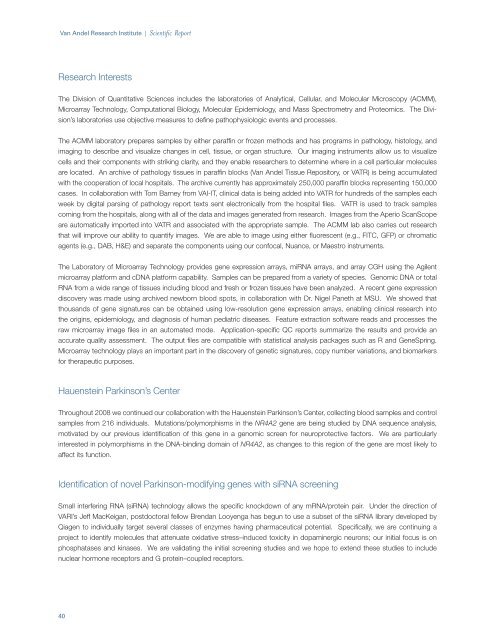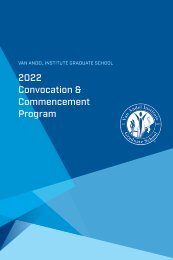2009 Scientific Report
Create successful ePaper yourself
Turn your PDF publications into a flip-book with our unique Google optimized e-Paper software.
Van Andel Research Institute | <strong>Scientific</strong> <strong>Report</strong><br />
Research Interests<br />
The Division of Quantitative Sciences includes the laboratories of Analytical, Cellular, and Molecular Microscopy (ACMM),<br />
Microarray Technology, Computational Biology, Molecular Epidemiology, and Mass Spectrometry and Proteomics. The Division’s<br />
laboratories use objective measures to define pathophysiologic events and processes.<br />
The ACMM laboratory prepares samples by either paraffin or frozen methods and has programs in pathology, histology, and<br />
imaging to describe and visualize changes in cell, tissue, or organ structure. Our imaging instruments allow us to visualize<br />
cells and their components with striking clarity, and they enable researchers to determine where in a cell particular molecules<br />
are located. An archive of pathology tissues in paraffin blocks (Van Andel Tissue Repository, or VATR) is being accumulated<br />
with the cooperation of local hospitals. The archive currently has approximately 250,000 paraffin blocks representing 150,000<br />
cases. In collaboration with Tom Barney from VAI-IT, clinical data is being added into VATR for hundreds of the samples each<br />
week by digital parsing of pathology report texts sent electronically from the hospital files. VATR is used to track samples<br />
coming from the hospitals, along with all of the data and images generated from research. Images from the Aperio ScanScope<br />
are automatically imported into VATR and associated with the appropriate sample. The ACMM lab also carries out research<br />
that will improve our ability to quantify images. We are able to image using either fluorescent (e.g., FITC, GFP) or chromatic<br />
agents (e.g., DAB, H&E) and separate the components using our confocal, Nuance, or Maestro instruments.<br />
The Laboratory of Microarray Technology provides gene expression arrays, miRNA arrays, and array CGH using the Agilent<br />
microarray platform and cDNA platform capability. Samples can be prepared from a variety of species. Genomic DNA or total<br />
RNA from a wide range of tissues including blood and fresh or frozen tissues have been analyzed. A recent gene expression<br />
discovery was made using archived newborn blood spots, in collaboration with Dr. Nigel Paneth at MSU. We showed that<br />
thousands of gene signatures can be obtained using low-resolution gene expression arrays, enabling clinical research into<br />
the origins, epidemiology, and diagnosis of human pediatric diseases. Feature extraction software reads and processes the<br />
raw microarray image files in an automated mode. Application-specific QC reports summarize the results and provide an<br />
accurate quality assessment. The output files are compatible with statistical analysis packages such as R and GeneSpring.<br />
Microarray technology plays an important part in the discovery of genetic signatures, copy number variations, and biomarkers<br />
for therapeutic purposes.<br />
Hauenstein Parkinson’s Center<br />
Throughout 2008 we continued our collaboration with the Hauenstein Parkinson’s Center, collecting blood samples and control<br />
samples from 216 individuals. Mutations/polymorphisms in the NR4A2 gene are being studied by DNA sequence analysis,<br />
motivated by our previous identification of this gene in a genomic screen for neuroprotective factors. We are particularly<br />
interested in polymorphisms in the DNA-binding domain of NR4A2, as changes to this region of the gene are most likely to<br />
affect its function.<br />
Identification of novel Parkinson-modifying genes with siRNA screening<br />
Small interfering RNA (siRNA) technology allows the specific knockdown of any mRNA/protein pair. Under the direction of<br />
VARI’s Jeff MacKeigan, postdoctoral fellow Brendan Looyenga has begun to use a subset of the siRNA library developed by<br />
Qiagen to individually target several classes of enzymes having pharmaceutical potential. Specifically, we are continuing a<br />
project to identify molecules that attenuate oxidative stress–induced toxicity in dopaminergic neurons; our initial focus is on<br />
phosphatases and kinases. We are validating the initial screening studies and we hope to extend these studies to include<br />
nuclear hormone receptors and G protein–coupled receptors.<br />
40

















